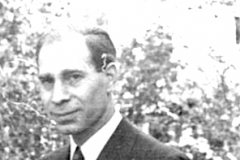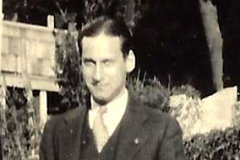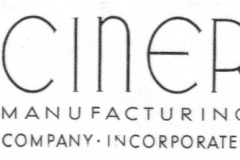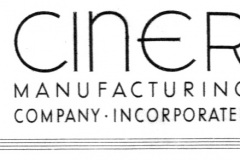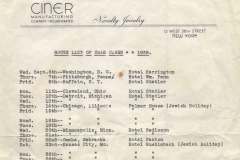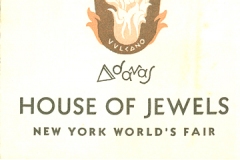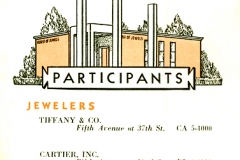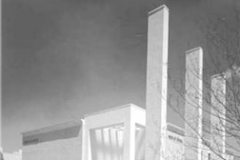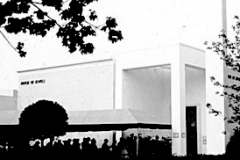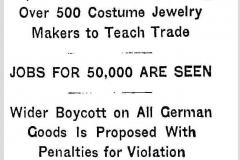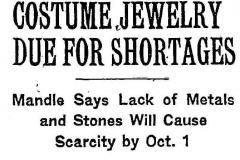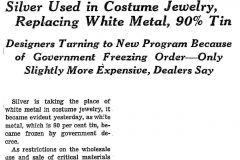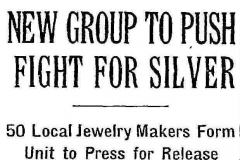From Manufacturers of Fine Jewelry to Manufacturers of Fashion Jewelry:
1929-1946
Sources: Interviews with Irwin Ciner and Charles Ciner. Ciner Manufacturing Company, “Ciner Historical Backgrounder,” 1992. Other sources as noted.
1929-1933
Late 1920s: Ciner Manufacturing Company Incorporated was a manufacturer of precious jewelry. During the 1920s, Emanuel Ciner had been joined by his sons, Irwin (b. 1902) and Charles (b. 1904). Their factory was located at 36 West 47th Street in New York City.
1929: The future of the fine jewelry business changed. With the onset of “Black Friday,” the demand for fine jewelry virtually disappeared.
-
- They found that they were becoming more bankers and loan agents than jewelers. They were forced to extend many notes of credit to customers who could now not pay for the items they ordered. They were not able to get paid for what they were making. They received notes which they had to turn in at the bank; they were always exchanging the notes for smaller amounts as they were getting paid something, but they were not getting cash. It was a difficult situation that nearly put them out of business.
- While the ability of the wealthy to pay for fine jewelry had largely disappeared, the demand for stylish accessories remained. To both stay in the business they loved and to avoid being saddled with the debt of Depression-battered customers, they looked for new opportunities.
1930: The Turning Point
-
-
- They went into the department store Saks Fifth Avenue, which was—and still is—at 50th Street and 5th Avenue in New York City. There they saw displays of imitation jewelry. Really not so much imitation jewelry was available at that time, but they saw pieces that had been imported from Europe. They were especially impressed by some exquisite costume jewelry from Germany. Marcasite pieces were made with the same approach they took with fine jewelry only without the gold, platinum and precious stones. They realized that the pieces were being sold at good prices; these were not the one-dollar or two-dollar novelty jewelry items that were sold from factories in Providence, Rhode Island.
- Marcasite jewelry was popular at that time. Marcasite was an iron oxide mineral (pyrite) with a dark metallic finish that was faceted and polished to look like a tiny diamond. They knew that tourists went to Europe and came back with marcasite pieces for themselves and for gifts. They looked at a lot of it and thought about the possibilities. Only one company was making marcasite pieces. It was in Providence, and it was only making the staple type of thing. Otherwise marcasite pieces only came from Germany or France.
-
1930: In their first costume jewelry venture, they hired a couple of German immigrant craftsmen who knew how make marcasite jewelry. They learned how to make marcasite pieces; they found a source to do the casting. In their factory on 47th Street, they had their own tool shop. They started making marcasite rings. They imported semi-precious stones like Carnelian, Lapis Lazuli, Chrysocolla, Rose Quartz, Amethyst, Quartz to use in the marcasite pieces.
1933: Since they did not have any experience selling marcasite jewelry, they sold to wholesalers in New York City. They started taking orders for 1000 to 2000 rings. They didn’t like selling to wholesalers. In 1933, they decided to sell directly to retailers, and they hired a couple of salesmen who knew how to call at the retailers.
1933-1938
1933: Ciner Manufacturing Co. Inc. had capital of $100,000. Emanuel was the president, Irwin vice-president and treasurer, and Charles was secretary.[1]
1933: Another turning point: They were still manufacturing both fine jewelry and fashion jewelry, but they knew they would have to give up one aspect of the business. Emanuel, Irwin and Charles made the decision: their future would be with costume jewelry.
1933: Decision to move. Based on that new path, they decided that their factory and showroom should be located in the “West 30s” with the other costume jewelers and not on West 47th Street with the precious jewelers. They also needed more space.
1934 ca.: They moved their business to 15 W. 36th St.—to a 16-story building constructed in 1917.[2] There they built what they considered to be a very nice factory and tool [casting] room.
1934: They gave up making fine jewelry and sold off all their precious stones.
1934 onward: With that commitment, they expanded their business. While they continued manufacturing marcasite pieces through 1939, they created their own line of fine costume jewelry, first in silver, then in ‘white metal.’ They used imported Swarovski rhinestones that they called “brillants.” Their faux diamonds were synthetic white sapphires imported from France.[3]
1930s: “Ciner—one of the few jewelry manufacturing companies that ventured into the early costume jewelry industry field…. Ciner was one of the first to recognize the need and enormous potential of good mass-produced costume jewelry. However, it took the lead in making fine jewelry for the high fashion market.”[As told to Lillian Baker, based on a telephone interview with Mr. Irwin Ciner, retired {1979-1985}].[4]
Ciner Manufacturing Company became the first and only American fine jeweler to make the switch to manufacturing high-quality, costume or fashion jewelry. Most of the companies that entered the costume jewelry business in the early days came from shoe-buckle manufacturing or started as costume jewelers.
1930s: They created a special design for “Ciner.” It was registered as the company’s trademark in 1949.
1937: Irwin (who had studied engineering), patented a Jewel Mounting Flexible Bracelet (March 16, 1937; No. 2,074.046). They manufactured these channel bracelets with clear and colored rhinestones mounted in sterling silver.
- Charles was the principal salesman until the World War II. In a small notebook, he kept careful records of all the department stores, specialty shops, and buyers he met. These personal relationships would continue for decades and formed the basis of their special relationships with its good customers.
- Copying designs of the most famous and successful costume fashion jewelry manufacturers was an on-going problem. Irwin Ciner participated in a project in 1939 to establish an association to combat style piracy. The efforts dissipated, probably due to the imminence of war.[5]
1939-1945
1939: New York World’s Fair. The House of Jewels exhibition of fine jewelry was very popular. Charles visited the Fair many times.
1939: Costume jewelry manufacturers react to rise of the Nazi Reich. by proposing a boycott of German products.
1940: With Europe at war after September 1, 1939, costume jewelry manufacturers anticipated shortages in materials.
1941: The United States was at war. Then manufacturing in white metal was restricted because tin could not be imported.
1942: 50 New York jewelry makers “campaigned to obtain release of Treasury silver.” Along with several others, Irwing [sic] Ciner of the Ciner Manufacturing Company was appointed to represent the group on the industry-wide committee.[6]
- Nearly 70% of the jewelry manufacturers were involved in the war efforts.[7]
- They joined the wartime economy and got into war production. They had some big orders assembling bombardier and gun sightings for Fairchild Camera Company. They developed more wartime products and were reasonably busy.
- They continued manufacturing fashion jewelry. Because they had government contracts, they could get some supplies that other jewelers could not get.
- During the war years, they did not send out salesmen
Notes
-
Polk’s New York City Street and Avenue Guide, 1933-4. ↑
-
Manhattan Telephone Directory, 1932-3. ↑
-
Joanne Dubbs Ball and Dorothy Hehl Torem, Masterpieces of Costume Jewelry (Atglen, PA: Schiffer, 1996) 70. ↑
-
Lillian Baker, 50 Years of Collectible Fashion Jewelry: 1925-1975 (Paducah, KY: Collector Books, 1986) 10. ↑
-
Roberto Brunialti and Carla Brunialti, American Costume Jewelry: Art & Industry, 1935-1950, A-M (Atglen, PA: Schiffer, 2008) 23. ↑
-
New York Times, September 3, 1942, 29. ↑
-
Melinda Lewis, The Napier Co. (Life by Design, 2013), 174. ↑

